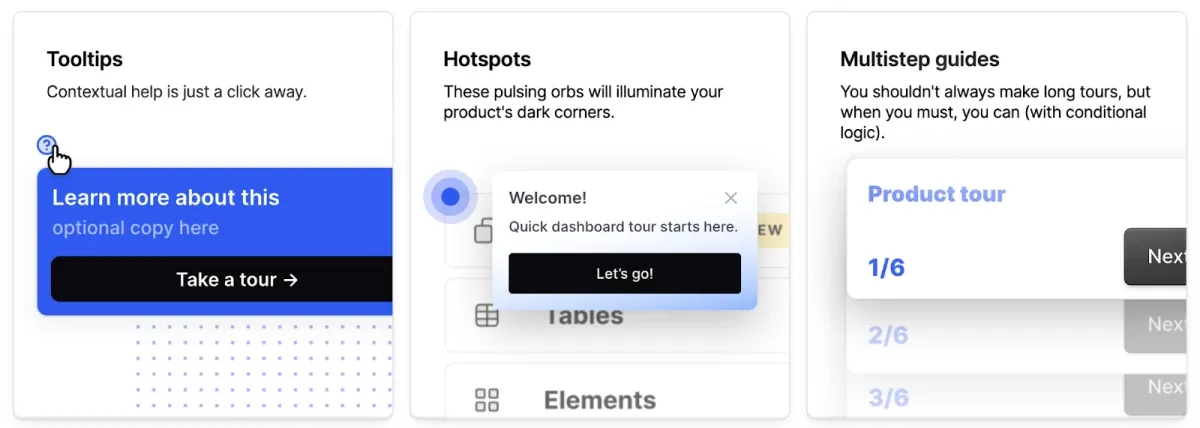You need to be implementing product-led customer success now
Imagine a world where your product itself is the driving force behind customer success, putting your CS operations on auto-pilot.

Imagine a world where your product itself is the driving force behind customer success, effortlessly guiding users, predicting their needs, and ensuring their satisfaction without requiring an army of support staff.
Lucky for you, we’re already entering an era of product-led customer success, where cutting-edge technology, smart design, and some good old-fashioned empathy join forces to create an experience that not only meets but anticipates and exceeds user expectations.
Traditional customer success
Customer success is one of the vertebrae of a strong SaaS company. They’re the ones who help every customer make the most out of the product they’re paying for.
The primary goals of these CS teams are to increase user adoption, satisfaction, retention, and overall growth by providing support and education. They’re responsible for onboarding new customers, training them on relevant product functionality, supporting them when issues arise, and overall building a positive relationship that sets the customer up to stick with the product (and the team) for the long term.
Main challenges
There are several significant challenges that customer success teams face, and many of them stem from the fact that traditional customer success relies heavily on human resources.
One of the main challenges is efficiency with a limited budget. Unfortunately, SaaS companies are often not as quick to invest in customer success budgets as they are in other departments like sales or product teams. CS teams are forced to make do, but since much of their success rests on the interactions that their team members need to have with customers, it can be expensive to provide the level of support they want to deliver.
This also leads to another major challenge: providing a consistent experience for and attention to all customers. Since the members of the CS team are only human, after all, and only have so much budget, they often have to make decisions on which customers to invest the most time with. This makes it difficult to provide a great experience for customers of all tiers.
And this can be a self-fulfilling prophecy in some ways. The low-paying customers receive minimal support, making them less likely to up their commitment going forward, leaving them at a low tier for their entire lifecycle, or worse, churning prematurely.
The shift to product-led customer success
This dilemma of traditional customer success’s reliance on human support has led leaders in the space to come up with an alternative solution. And that solution lies in technology-driven, product-led customer success.
This emerging strategy emphasizes the product as a potentially major driver of growth and success, baking moments of support and engagement into the product experience itself. Some aspects of customer engagement are put on auto-pilot, giving continuous attention to all customers.
This, in turn, can help to maximize impact while reducing the need for extensive human resources. Since customer success teams will be supported by more technology, which takes a lot of tedious tasks off their plates, they have a better overall employee experience and have more energy to bring to the interactions they are having with clients.
Product-led customer success is a win/win for both customers and CS teams. Here’s how this strategy looks in practice.
Gauging user sentiment in-product
One of the main objectives of customer success teams is to get an accurate read on how customers feel about their experience with the product and the level at which they’re engaging. In traditional customer success, teams uncover this insight in regular check-ins via email, video calls, or even in-person visits.
But it’s 2024. There’s no reason that we should be relying on human conversation alone to uncover user sentiment.
In-product data collection
When customers are happy with a SaaS product, they’re likely to use it more. So, collecting data within your product on their engagement is a key strategy to support customer success operations. Using tools like Google Analytics, Command AI, and Hotjar, you can track how specific users are interacting with your product.
By measuring things like usage patterns, feature adoption, and interaction frequency, CS teams can identify areas of strengths or weaknesses.
Collecting feedback
Explicit feedback is also valuable, but technology helps you not only alleviate the burden from your team of manually collecting this data but also helps you be more strategic and granular about how and when you collect this data.
For example, using user assistance tools like Command AI, you can shoot out specific surveys at key moments like after using a certain feature for the first time or when confusion is detected. This helps you to pinpoint the impact that specific experiences have on your user and collect rich data to either amplify the good or cut out the bad.
I’m going to talk about chat more in depth below, but I want to quickly mention how valuable it can be for collecting feedback, too. If you have chatbots powered by cutting-edge conversational AI, helping you create human-like conversations sans human, your users are more likely to open up and share what they’re feeling. They can probe deeper into what your customers are saying to get to the heart of what matters most.
Once you collect all of the engagement data and feedback, you can double-down on the auto-pilot strategy by letting technology give you a head start with analyzing data and pulling out actionable insights.
The role of chat
So much of what puts the “success” in customer success is the human touch. That’s what’s made this role historically tough to scale. But thanks to advancements in conversational AI, this is becoming less of a challenge.
In-product chatbots that are able to imitate (and more importantly, understand) human interaction at an increasingly sophisticated level are invaluable for real-time user support and proactive engagement.
Much of the tasks on customer support’s plates can be shifted away with chat-supported clarification and user guidance. If your chatbots are backed by great AI, and you feed them the right, most up-to-date data on your product, it can help to provide automated support by clarifying issues that your users are asking in their own words.
Chatbots are nothing new. Plenty of SaaS users are used to chatbots being the first line of defense for their issues. But as soon as they see that they only have a limited set of issues to choose from or are dismayed that the bot didn’t understand them, they impatiently smash the enter key when sending a “talk to agent” message. Shifting to more of an “AI agent” model that product-led customer success requires resolves this and provides genuinely helpful and personalized support, freeing up your human agents for other work.
Chat can provide more than just support, though. Your AI agents can also proactively engage your users to drive a better overall experience. Here are a few example scenarios where a chat message may pop up for a user:
- A user has been idle on a page for a certain period → "It looks like you’ve been inactive for a while. Is there something you’re looking for or need help with?"
- A user is spending time on a specific feature but hasn't utilized it fully → "Hi there! I see you're exploring [Feature Name]. Would you like a quick tour or some tips to get the most out of it?"
- A user's subscription is nearing its renewal date → "Your subscription is up for renewal soon. Do you have any questions about the renewal process or need assistance with your account?"
Personalized nudging for customer success
Sometimes, users just need a little nudge to up their engagement in the product.
Personalized nudges are small pop-up prompts that you program in your product to guide users toward actions that enhance their experience and ensure their success with the product.
Designing effective nudge campaigns begins with a deep understanding of user behavior and sentiment. By leveraging insights from user data and sentiment analysis (which we’ve already helped you automate above), you can create nudges that are not only relevant but also timely and actionable.

Some examples of helpful nudges to create include:
- Tips: Provide users with helpful tips based on their current activity. For example, if a user is exploring a complex feature for the first time, a tip might appear to guide them through the initial steps.
- Reminders: Remind users about tasks or features they haven’t yet explored but could benefit from. For instance, if a user hasn’t set up their profile completely, a gentle reminder can encourage them to do so.
- Educational Content: Offer links to tutorials, articles, or videos that can help users better understand and utilize your product. This is especially useful for features that require a bit of learning to master.
Using technology like Command AI, you can get really specific about these nudges. Instead of blasting generic messages to every user, you can take a more granular approach and trigger nudges based on criteria you set, like the segment that a user belongs to, engagement history, or any other relevant factors.
This is nothing completely new, it’s just better
All of these product-led customer success tasks are things that CS teams have been doing themselves for years. Modern teams are just lucky that the technology exists now to help fill in the gaps and take several tasks off their plate.
Thanks to all of these new CS tools, teams are not only able to save time, helping alleviate burnout and quality of service provided, but customers are also able to get more timely, more personalized, and overall more effective support, in turn leading to more long-lasting relationships.
